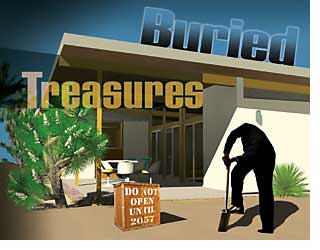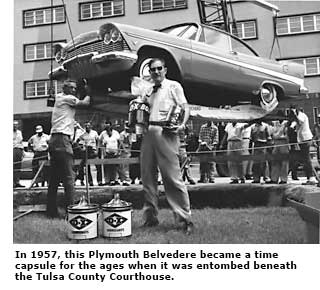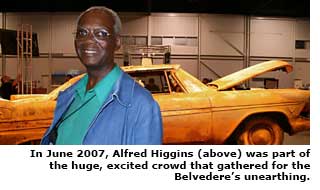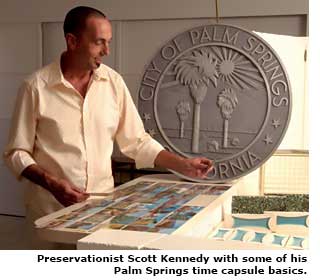Buried Treasures: Unearthing Time Capsules
 It's easy for Scott Kennedy to travel backwards in time. He just closes his eyes and returns to Palm Springs as it was 50 years ago, in the first flowering of modernism—long before he had ever seen the city.
It's easy for Scott Kennedy to travel backwards in time. He just closes his eyes and returns to Palm Springs as it was 50 years ago, in the first flowering of modernism—long before he had ever seen the city.
Kennedy, who has served on the Palm Springs Modern Committee, a group dedicated to preserving the desert's modern architecture, owns 250 postcards showing Palm Springs in its historic prime. He has brochures from the sleek resorts, menus from the favorite restaurants, even photos taken by vacationers using their Brownie cameras. "But there are holes," he admits. His image of the town, he says, is made up largely "of just blips—a bank here, another building there."
If only he could find a time capsule planted in 1957 by some prescient local who'd gotten carried away with a Bolex 16-millimeter movie camera, hopped in his Ford Fairlane, and cruised slowly through Palm Springs, "down Palm Canyon Drive, all the way through downtown," he says. "Or maybe from one end of the Valley to the other—from Indio to Palm Springs. "How nice that would be."

If Kennedy were putting together a time capsule today for people to discover in 2057, that is exactly what he would put in it. "Fifty years from now, it would be great to see what Palm Springs looks like today, from street level," he says. "This may become especially important since there is now such enormous pressure to redevelop downtown with taller projects and ones that could impact the town's majestic boulder-strewn hillsides."
Time capsules—a quaint idea, many may think—made it into the headlines earlier this year, when a 1957 Plymouth Belvedere was unearthed from the courtyard lawn in Tulsa, Oklahoma. Back in '57 the car was buried at the Tulsa County Courthouse to mark Oklahoma's 50th year of statehood.
Though the car—with its signature fins and whitewall tires—emerged "a mess," according to the hot-rodder who tried to start her up, the story got people thinking about time capsules. For one thing, a real time capsule that was buried alongside the car emerged with its contents—everything from containers of gas and oil and a bottle of tranquilizers to bobby pins and an unpaid parking ticket—absolutely intact.

Tremendous enthusiasm greeted the opening of the capsule and the unearthing of the car—which is another reason to create a time capsule in the first place. What better way to get people thinking about the past or contemplating the future?
Alfred Higgins watched the Tulsa capsule getting buried on his black-and-white TV as a 13-year-old boy. "Back then," he says, "50 years seemed like it was 100 years away." Higgins showed up in person to watch it being exhumed. Much of the town turned out, he says. "The crowd was overwhelmingly excited at that capsule being opened because it was a piece of Oklahoma history." He found the experience emotionally affecting. Old movies and photos of Tulsa strongly evoked the past—and made him sad "because it brought back a lot of memories of my people," he says. "They're all gone now but me."
Finding artifacts from the past—whether in a time capsule or in less dramatic form—can be valuable. Objects, news clippings, and photos can tell a story about a neighborhood, a house, a person—and in that way, bring it alive.
Buildings are lost without their stories. What good does it do a house that George Washington slept in if no one knows he'd ever been there? But if we know who built a house, why it looks and functions the way it does, and who lived there, we can understand why it's special. The same goes for neighborhoods and cities. A time capsule can do more than tell a story. It can spur neighborhood and architectural preservation.
The modernist architect Felix Warburg, who has unearthed two time capsules from historic buildings (at San Francisco synagogues Ohabai Shalome and Beth Israel), emphasizes how important it is to know the story behind a building to justify its preservation. "It places it in a perspective that will remind people of its importance," he says.

Just ask Steve and Pam Wedel about the value of historic objects. Shortly after they bought their home near Sacramento, they found photos of the home's first owners, an African-American doctor and his family. Their house was a custom design by architect Carter Sparks, who is best known for his tract homes for Streng Bros. Homes.




